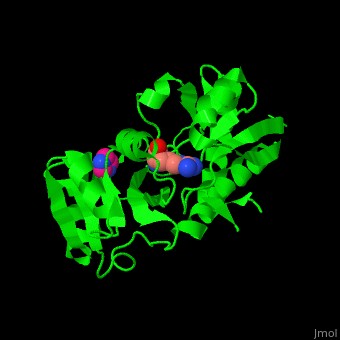ABC transporter
From Proteopedia
(Difference between revisions)
| Line 5: | Line 5: | ||
== Function == | == Function == | ||
| - | ABC Transporters | + | ABC Transporters have two main functionalities acting either as exporters or importers. '''ABC ''Exporters''''' release bound drugs to the extracellular environment, while '''ABC ''Importers''''' accept substrate molecules from their relevant substrate-binding proteins<ref name="biochembook"/>. For instance the Vitamin B12 transporter BtuCD (PDB [[1l7v]]) is a binding protein-dependent ABC transporter system that uses the power of ATP hydrolysis to pump vitamin B12 into the cytoplasm of E. coli<ref name="BtuCD-Ecoli"/>. |
| - | '''ABC Exporters''' | + | '''ABC Exporters''' use ATP to drive import and export functions providing multidrug resistance. In eukaryoles, for instance, ABC Transporters are problematic because they export therapeutic drugs such as those used in chemotherapy regimens, which must be changed frequently to avoid the rejection of the drugs<ref name="biochembook"/>. |
| + | |||
| + | == Structural highlights == | ||
To achieve export, ABC transporters require a minimum of four domains. Two transmembrane domains (TMDs) form the ligand binding sites and provide specificity, and two NBDs bind and hydrolyze ATP to drive the trans-location of the bound ligand. The NBDs, but not the TMDs, are homologous throughout the family and have several characteristic motifs including the Walker A and B motifs common to many nucleotide binding proteins and others like the ABC signature, stacking aromatic D, H, and Q loops, which are unique to the family<ref name="FourDomainsABCT"/>. | To achieve export, ABC transporters require a minimum of four domains. Two transmembrane domains (TMDs) form the ligand binding sites and provide specificity, and two NBDs bind and hydrolyze ATP to drive the trans-location of the bound ligand. The NBDs, but not the TMDs, are homologous throughout the family and have several characteristic motifs including the Walker A and B motifs common to many nucleotide binding proteins and others like the ABC signature, stacking aromatic D, H, and Q loops, which are unique to the family<ref name="FourDomainsABCT"/>. | ||
Revision as of 10:42, 21 October 2015
| |||||||||||
3D Structures of ABC transporter
Updated on 21-October-2015
References
- ↑ 1.0 1.1 Huls et al. The Role of ATP Binding Cassette Transporters in Tissue Defense and Organ Regeneration. Journal of Pharmacology and Experimental Therapeutics, 2008; 328 (1)
- ↑ 2.0 2.1 2.2 Garrett R, Grisham CM. Biochemistry. 2008. 1059 pages
- ↑ 3.0 3.1 Linton KJ, Higgins CF. The Escherichia coli ATP-binding cassette (ABC) proteins. Mol Microbiol 28: 5–13, 1998
- ↑ 4.0 4.1 4.2 Linton KJ. Structure and Function of ABC Transporters. Physiology 22: 122-130, 2007; doi:10.1152/physiol.00046.2006
- ↑ 5.0 5.1 Borths EL. Structural and biochemical characterization of the vitamin B12 ABC transporter, BtuCD-F. Dissertation (Ph.D.), California Institute of Technology. 2005
Proteopedia Page Contributors and Editors (what is this?)
Michal Harel, Alexander Berchansky, Joel L. Sussman, Zina Saadi

